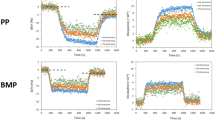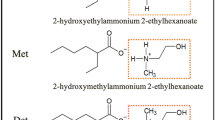Abstract
The lubrication by ionic liquids (ILs) is a promising means for reducing wear and friction. Nowadays, phosphorus-, sulfur-, and halogen-free protolytic ionic liquids (PILs) are becoming increasingly popular. As compared to other ILs, they are cheaper and easier to produce. In this work, three protolytic ionic liquids composed of different amines and oleic acid have been studied. Phosphorus-containing ionic liquid, engine oil, and synthetic base oil have been used for comparison. The studies have been performed using a tribometer with a sliding reciprocating motion for a ball–plane friction pair. The friction pairs have been tested at a temperature of 30°C and under a load of 1 N for 30 min. In the study, three friction pairs based on different metals such as steel–steel, steel–stainless steel, and steel–aluminum have been used. The results show that ILs are efficient in reducing friction, but the lowest friction coefficient does not always coincide with the lowest wear level. A phosphorus-containing IL had the best lubricating properties in this study. The investigated PILs provide the most efficient lubrication in the case of a steel–steel friction pair. In this case they are much more efficient than motor oil. PILs form an adsorption layer that exhibits an extremely low friction coefficient on the surface of steel. However, owing to an intense tribocorrosion process, the PILs are not suitable for the lubrication of friction pairs containing stainless steel and aluminum.






Similar content being viewed by others

REFERENCES
Ye, C., Liu, W., Chen, Y., and Yu, L., Room-temperature ionic liquids: a novel versatile lubricant, Chem. Commun., 2001, no. 21, pp. 2244–2245. https://doi.org/10.1039/B106935G
Amiril, S.A.S., Rahim, E.A., and Syahrullail, S., A review on ionic liquids as sustainable lubricants in manufacturing and engineering: recent research, performance, and applications, J. Clean. Prod., 2017, vol. 168, pp. 1571–1589. https://doi.org/10.1016/j.jclepro.2017.03.197
Austen Angell, C., Ansari, Y., and Zhao, Z., Ionic liquids: past, present and future, Faraday Discuss., 2012, vol. 154, pp. 9–27. https://doi.org/10.1039/C1FD00112D
Shi, Y. and Larsson, R., Non-corrosive and biomaterials protic ionic liquids with high lubricating performance, Tribol. Lett., 2016, vol. 63, p. 1. https://doi.org/10.1007/s11249-016-0692-9
Song, Z., Liang, Y., Fan, M., Zhou, F., and Liu, W., Ionic liquids from amino acids: fully green fluid lubricants for various surface contacts, RSC Adv., 2014, vol. 4, no. 37, pp. 19 396–19 402. https://doi.org/10.1039/C3RA47644H
Kreivaitis, R., Gumbytė, M., Kupčinskas, A., Kazancev, K., and Makarevičienė, V., Investigating the tribological properties of PILs derived from different ammonium cations and long chain carboxylic acid anion, Tribol. Int., 2020, vol. 141, art. ID 105905. https://doi.org/10.1016/j.triboint.2019.105905
Qu, J., Blau, P.J., Dai, S., Luo, H., Meyer, H.M., and Truhan, J.J., Tribological characteristics of aluminum alloys sliding against steel lubricated by ammonium and imidazolium ionic liquids, Wear, 2009, vol. 267, pp. 1226–1231. https://doi.org/10.1016/J.WEAR.2008.12.038
Stachowiak, G.W. and Batchelor, A.W., Engineering Tribology, Ch. 13: Corrosive and Oxidative Wear, Amsterdam: Elsevier, 2014, pp. 597–620. https://doi.org/10.1016/B978-0-12-397047-3.00013-8
Funding
The study was financially supported by a grant (no. S-MIP-17-52) of the Lithuanian Scientific Research Council.
Author information
Authors and Affiliations
Corresponding author
Additional information
Translated by O.Polyakov
About this article
Cite this article
Kreivaitis, R., Gumbytė, M., Kupčinskas, A. et al. Lubricating Properties of Ammonium-Based Protolytic Ionic Liquids in Friction Pairs Based on Different Metals. J. Frict. Wear 42, 152–159 (2021). https://doi.org/10.3103/S1068366621030089
Received:
Revised:
Accepted:
Published:
Issue Date:
DOI: https://doi.org/10.3103/S1068366621030089



